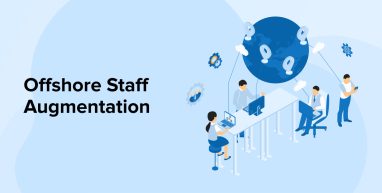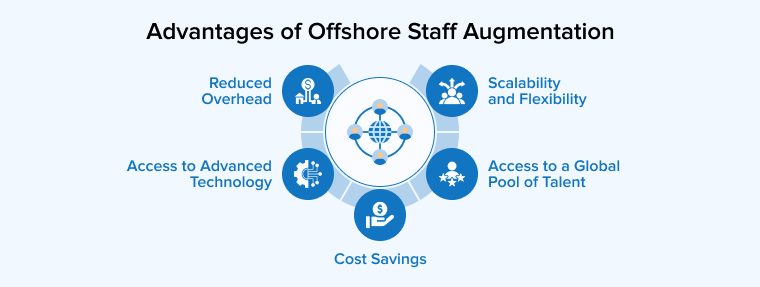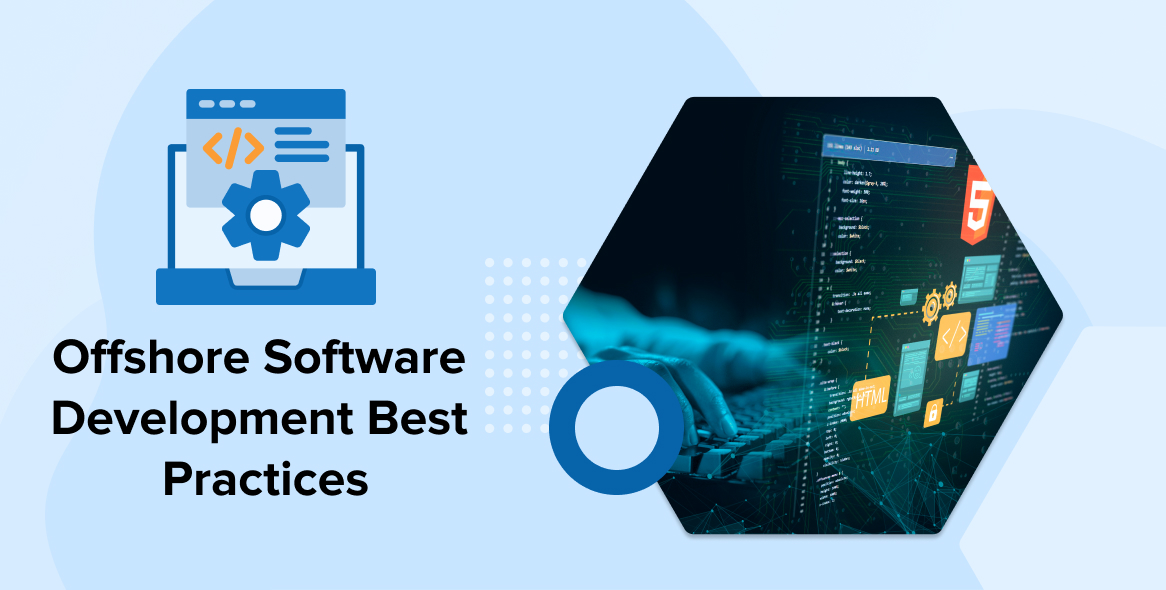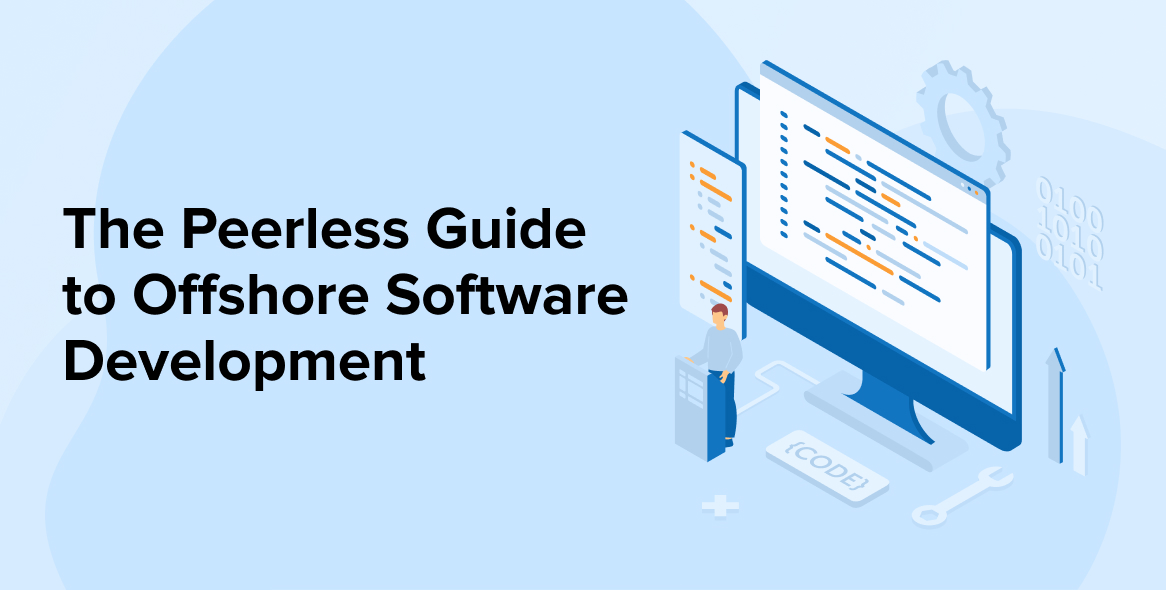
Companies can acquire the necessary talent in a cost-effective manner at any time through offshore staff augmentation. Partnering with an offshore software development company can help organizations overcome local talent shortages and get skilled professionals without spending much.
In this blog, we’ll discuss the concept of offshore staff augmentation, uncovering its various aspects. We’ll understand the advantages, disadvantages, different models, and the implementation process of offshore staff augmentation.
1. Overview of Offshore Staff Augmentation
Offshore staff augmentation is the process of hiring professionals with the necessary expertise from other countries, generally located on different continents. These countries often have lower production costs and more affordable labor. Companies contact a third-party service provider to get remote workers for their projects, effectively filling the resource gaps in their existing in-house teams. Offshore professionals can be hired on either a contract or a long-term basis.
Offshore staff augmentation is different from traditional outsourcing. Here, clients don’t hand over the entire project development responsibility to the offshore team. The external staff function as extended members of the internal team, collaborating closely with in-house project managers.
Further Reading on: Staff Augmentation vs Outsourcing
1.1 Advantages of Offshore Staff Augmentation

The global staff augmentation market is experiencing steady growth. Below are the key advantages that explain the reasons behind this growth.
1. Access to a Global Pool of Talent
Companies can access the global talent pool by utilizing the international staff augmentation market. This approach allows businesses to avoid relying on inexperienced workers available locally and compromising the product quality. This is the opportunity to access hard-to-find skills and expertise based on your project requirements without giving control to third-party providers.
2. Cost Savings
Cost is the prominent factor when considering hiring employees with exceptional skills. Offshore staff augmentation allows companies to avoid the substantial expenses associated with hiring full-time employees and spending on their training, benefits, and salaries. This approach can result in a huge cut down on operational and labor costs. You get premium talent by partnering with reputable offshore agencies.
3. Scalability and Flexibility
Hiring in-house workers can lead to challenges, you cannot remove them when they are no longer needed. Companies may face adverse effects of layoffs. However, the staff augmentation approach allows businesses to quickly scale the team size according to the changing project needs, market scenarios, and business goals. You are flexible in hiring and terminating team members whenever required. This improves the efficiency of businesses, especially startups.
4. Access to Advanced Technology
Offshore outsourcing companies work with different companies across different technologies worldwide. Therefore, offshore employees are not only highly skilled but also use advanced tools according to the latest technological trends. When you hire offshore team members, you introduce the latest technology into your project that isn’t feasible locally. It gives you a competitive edge over competitors and maximizes revenue and growth.
5. Reduced Overhead
This strategy cuts overhead costs, allowing businesses to allocate the savings to crucial business operations like marketing and research.
1.2 Challenges and How to Overcome Them
The multiple benefits of offshore staff augmentation make it a popular business approach. However, there are certain limitations that clients must consider before opting for staff augmentation services and finding ways to overcome them.
Let us discuss the four dominant offshore staff augmentation limitations and their potential solutions:
1. Communication Barriers
Limitation: The work environment and cultural diversity in offshore countries can become obstacles to collaboration and communication. There are chances of misunderstandings and disagreements due to incomplete or improper understanding of requirements.
Solutions:
- Appoint a client success manager for projects to ensure both teams are aligned.
- Develop an inclusive environment where team members feel comfortable asking questions and clarifying doubts.
- Use communication tools like MS Teams and Zoom for systematic, regular meetings and updates.
- Organize language and cultural training sessions to ease communication.
2. Differing Time Zones
Limitation: Your offshore staff augmentation partner may be located in a country with a different time zone. Hence, time zone differences can result in communication lapses and unnecessary delays.
Solutions:
- Plan and make a proper schedule for meetings and interactions with the offshore development team.
- Employ the right project management software to track individual work and facilitate asynchronous collaboration.
3. Quality Control
Limitation: Quality control standards, practices, and tools vary from country to country and organization to organization. This variability can affect product quality, making it challenging to ensure that the offshore team meets the same quality benchmarks as the in-house teams.
Solutions:
- Establish proper quality control metrics and practices to enhance performance.
- Employ standard quality assurance tools and techniques to determine quality issues.
- Conduct regular reviews and check-ins to timely resolve the issues.
4. Hidden Costs
Limitation: The selected offshore agency may not provide a clear breakdown of its pricing structure. There could be hidden expenses, such as fees for communication tools and unknown service charges, which you might only discover later on
Solutions:
- Conduct comprehensive research about your potential offshore staff augmentation partner.
- Prepare extensive agreements detailing everything from payment structure to unexpected expenses.
- Regularly review the expenses and figure out the deviations from the predefined considerations.
2. Offshore Staff Augmentation: Working Models
There are different reasons why companies opt for offshore staff augmentation services. The engagement or relationship between clients and offshore staff augmentation partners varies from project to project. Therefore, it is essential to decide which type of cooperation model you need from the offshore service provider.
Three fundamental staff augmentation models that will help you determine the most suitable one based on business objectives:
2.1 Dedicated Team Model
In this offshore staff augmentation model, the offshore agency provides a dedicated team of professionals who work exclusively for a specific client. This model ensures seamless coordination and integration between the offshore team and the in-house staff, which can lead to improved work efficiency and project delivery timelines.
The dedicated team model is the most flexible one, allowing clients to maintain complete control over their new team members. In this arrangement, the service provider handles the recruitment and HR-related processes of these team members. It’s the perfect offshore model for long-term projects and those that require ongoing support and continuous development.
2.2 Project-Based Model
Clients select this model to hire offshore staff for a specific project. The augmented staff works for the client until the project’s completion. The offshore staff augmentation partner terminates the engagement once the project is completed and the team is scaled down. These projects have a predefined scope and timeline and typically require specialized expertise for a short duration.
2.3 Hybrid Model
A hybrid model combines elements of both dedicated team and project-based models. It helps companies leverage the best features of each model while effectively balancing onshore and offshore collaboration. If your company is large and involved in multiple development projects at a time, this model best suits your requirements. The organization can opt for a dedicated team, a project-based setup, or a combination of both. The hybrid approach offers customized solutions at an optimized cost with the strategic combination of different approaches. However, effective managerial skills are required to utilize this approach in the best possible manner, as different resources and responsibilities are involved.
3. Steps to Implement Offshore Staff Augmentation
It’s important to follow the correct approach to implement offshore staff augmentation for a successful project outcome.
Follow the step-by-step procedure below to include the augmented staff in your internal team:
3.1 Identify Your Needs and Goals
Thoroughly analyze your project requirements and determine what the existing in-house team lacks. What specific expertise does the project demand, and for how long? Do you require an individual professional or a team of skilled professionals? What is the project timeline? Is the collaboration feasible between the in-house and offshore teams? These are essential questions to answer to gain a clear picture of your project’s needs.
3.2 Search For Professionals in the Required Fields
Now that the gaps in the existing team have been identified, begin searching for the required number of skilled professionals according to the project needs. Find out which offshore service providers specialize in your required domain. Make a list of prominent offshore agencies in the market after analyzing several aspects such as pricing structure, availability of offshore resources, and company culture. If possible, seek recommendations and references from acquaintances or colleagues to enhance your search.
3.3 Review Previous Cases, Reputation, and Expertise
After shortlisting potential third-party service providers, evaluate their previous track record and market reputation. Analyze their experience in similar projects and review client testimonials to validate your research. Aim to select a staff augmentation company that has experience in a diverse range of technologies, as this diversity will ensure good product quality.
3.4 Set Up Communication and Project Management Protocols
Effective and regular communication is the key to successful offshore outsourcing. Therefore, clients must predefine the communication protocols to ensure smooth collaboration. This includes defining the communication channels, such as email, Zoom meetings, and messaging platforms., Additionally, it is important to outline the meeting schedule and format.
Assign the roles and responsibilities within the development team based on a clear set of criteria. Establish milestones and timelines for project phases, and implement appropriate task management software to track progress and manage tasks. Regular sessions must be held to resolve doubts and queries to ensure consistency in project execution.
3.5 Sign a Contract
Contract signing is the final step in the offshore staff augmentation onboarding process. This contract must contain all terms, conditions, and responsibilities of the respective parties involved. After documentation, the contract must be thoroughly reviewed to make sure that it covers every detail, thereby preventing future misunderstandings. All signing parties must agree to the provisions and approve the legally binding agreement.
4. Final Words
Software development projects can benefit greatly from IT staff augmentation and enhance business growth. Offshore staff augmentation is an opportunity to access specialized skills without spending much to promote cost efficiency. It optimizes resource allocation by outsourcing non-core functions and investing in meeting strategic initiatives. So, if you’re an offshore software development company, it is essential to formulate a business strategy that effectively utilizes the advantage of offshore staff augmentation services.
FAQs
What is offshore staff augmentation?
Offshore staff augmentation is a business strategy that involves enhancing the in-house team with skilled offshore professionals. This approach allows companies to leverage the global talent pool and fill the internal team’s skill gap.
How does offshore staff augmentation help reduce costs?
The companies do not need to hire experts through the traditional hiring method; thus, there is no onboarding and employee benefits overhead. You will save your infrastructure expenses with offshore hiring, unlike the case of in-house employees.






Comments
Leave a message...